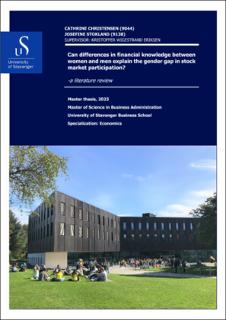| dc.description.abstract | Gender differences in stock market participation are a well-known phenomenon characterized by the underrepresentation of women for several years, both in terms of number of participants and the total value of stocks involved. Recent research has pointed to the correlation between increased financial knowledge and stock market participation. Therefore, this study aims to examine whether differences in financial knowledge between women and men can explain the gender gap in the stock market. At the same time, it investigates whether the two subcomponents overconfidence and risk – which are two consequences of varying levels of financial knowledge – influence the decision to participate in the stock market. Through a literature analysis, previous research has been systematically collected, analyzed, and discussed. The literature analysis reveals that women and men's decision to participate in the stock market is based on different foundations. For women, it is crucial to possess high actual financial knowledge, specifically advanced knowledge, to invest in the stock market, compared to men where both high actual and perceived financial knowledge is important. Given that women exhibit lower levels of actual and perceived, as well as general and advanced financial knowledge compared to men, it is crucial to increase women's actual financial knowledge to enhance their stock market participation. This is supported by the finding that women exhibit a higher degree of overconfidence, defined as perceived high and actual low financial knowledge, compared to men. However, this literature analysis finds that overconfidence cannot be generalized for both genders, as findings suggest that overconfidence leads to lower risk tolerance for women in comparison to higher risk tolerance for men. Therefore, increased advanced financial knowledge among women can result in a lower degree of overconfidence and ensure a more balanced gender distribution in the stock market. | |
